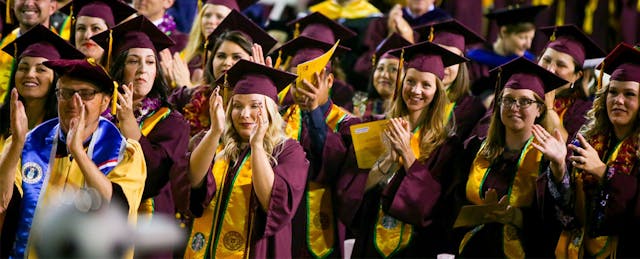Angela Humberstone’s college experience afforded no idyllic afternoons studying on a campus quad.
In between daily work shifts at a hotel in the morning and at a Starbucks in the afternoon, she squeezed in a few hours of homework, sometimes also allowing herself a brief nap in her car.
The arrangement was possible logistically because Humberstone took her courses in business and environmental sustainability entirely online. And it was feasible financially because Starbucks and Arizona State University covered most of her tuition bill.
“Getting a bachelor’s, for me, was something I didn’t think I was ever going to do. It was out of my reach, monetarily wise,” says Humberstone, who lives in San Diego. “I really didn’t want to get a loan and be in debt thousands of dollars when I came out of school and not know what I was going to do. I was turned off of traditional college in that sense.”
Yet in May, Humberstone crossed the commencement stage at ASU, becoming one of nearly 3,000 Starbucks employees who have earned bachelor’s degrees online through the company-university partnership program.
“It was amazing,” Humberstone says of the ceremony. “It really kind of seals it in for you that you accomplished that major step.”
It’s been five years since the launch of the Starbucks College Achievement Plan, which combines scholarship and reimbursement funds to help baristas, store managers and other employees earn their first bachelor’s degrees at minimal personal cost.
Having learned what works and what doesn’t for this group of adult learners, officials at both the coffee company and the university say they remain optimistic they’ll fill the venti-sized goal they originally set for themselves: reaching 25,000 graduates by 2025.
The program’s generous terms—such as extending tuition benefits to part-time workers after only a few months on the job and allowing employees to choose their majors among nearly 80 subjects—made it unique when it kicked off in 2014 (and won it plenty of attention, including a cover story in The Atlantic). Today, the program has plenty of peers, with other major companies including Walmart, Disney, Taco Bell and JetBlue offering college-support programs of their own.
Leaders at Starbucks and ASU say they welcome the competition. After all, corporate college programs have the potential to erode “the notion of exclusivity” that “a college degree is meant for a certain group of individuals who can afford it,” says Lisa Young, executive director of Starbucks Initiatives for EdPlus at Arizona State University.
“I would recommend this be done as much as possible, in as many mechanisms as possible,” she says.
Lessons Learned
As of spring 2019, there were about 12,000 Starbucks employees enrolled in ASU classes. They were a force to be reckoned with, accounting for 27 percent of all ASU online students that semester.

Two-thirds of Starbucks retail stores have an employee participating in the program, and nearly 500 stores have five or more workers enrolled. All these students yield a lot of data, which has helped Starbucks and ASU tweak their partnership over the last half-decade.
For example, Starbucks employees have to meet ASU admission criteria to participate, yet about 20 percent of program applicants don’t qualify. So the two institutions created Pathway to Admission, a bridge program that offers Starbucks workers remedial online courses to get them ready to participate fully.
That helped Juan Ferguson. Despite having attended two years of college at Florida International University, the barista at a D.C. Starbucks needed to boost his credentials to transfer into ASU. He considers the pathway program time well spent: “You still get college credit; it’s not like I lost credits or anything.”
Other interested companies and colleges should not underestimate the amount of support the Starbucks program requires, Young says. ASU and Starbucks each have small teams dedicated to its operations, plus draw on effort supplied ad hoc by other staff members.
“To scale this, it’s not something you can do really easily,” Young says.
Rather than try to mimic the Starbucks model exactly, Young advises that any companies interested in jumping in devise programs that fit the goals and needs of their workers and be prepared to adapt on the fly.
“Putting a blueprint in place and hoping for the best doesn’t work,” Young says. “There’s not just an operating manual and Starbucks has a copy and ASU has a copy and we all just follow the manual. We’re iterating.”
Overcoming the Online Stigma
One of the program’s most important findings is that many workers are initially skeptical of taking courses online, says Mary Dixon, who directs the partnership for Starbucks. This is the case even though the online instruction model offers the flexibility many working adults need to accommodate their busy schedules.
The Starbucks program tries to address this apprehension by offering new students an orientation course that teaches them how to make the most of online learning systems.
“At first I thought I wasn’t going to be very good at online classes,” Humberstone says. “But once I realized that this is a great opportunity, I figured if I put my focus in and really make sure I’m on top of everything, I should be successful.”
Word-of-mouth recommendations among baristas have contributed to the program’s success, Dixon says.
For example, Ferguson has been so impressed by the program that he’s encouraged friends and family members to apply for Starbucks jobs and enroll at ASU. His father, who started college years ago but didn’t graduate, took his advice, hoping to qualify for more senior job opportunities. Now, Ferguson says, they’re taking the same ASU history class.

“He’s been out of school for so long, but he’s really smart. We’re on week five of the work but he’s already on week seven. He’s moving, he’s killing it,” Ferguson says. “We have the same graduation date; that would be pretty cool, too.”
Starbucks students have devised their own ways to incorporate human interaction into their online experiences, such as by using the company’s intranet message boards to chat with classmates.
Balynda Cota, a 17-year Starbucks veteran and district manager in San Jose, intentionally signs up for the same classes as another participant in the program. She also seeks feedback from ASU tutors who can help edit her papers via screen-sharing technology.
At the start of one of Ferguson’s early ASU classes, he noticed that a few other students were also Starbucks employees based in D.C. He walked into their store to introduce himself and walked out with a new set of study partners.
Goals Achieved
The college program has clear benefits for students. But it also bears rewards for the institutions that support it.
Arizona State University provides an upfront scholarship to Starbucks employees that covers 42 percent of tuition costs. In return, the school gets to collaborate with the coffee company in recruitment efforts—no small prize, since marketing efforts can cost online degree programs millions of dollars.
“This means that when a prospective student from Starbucks contacts us, the likelihood of enrollment is higher than an unaffiliated prospect that may be considering a number of schools. Also, when students leave the Starbucks benefit, they will generally continue their degree without the scholarship,” said Karen Smith, chief financial officer for EdPlus at Arizona State University, in an email interview. “This contributes to managing overall acquisition costs.”
Additionally, ASU’s success working with Starbucks “has created a positive reputation with other companies and students that further benefits our acquisition and growth.”
In a tight labor market, many companies struggle to attract and retain workers. The education-support program has helped Starbucks do both. Nearly a fifth of all job applicants now cite the college program as one of their main motivators to don the green apron. Participants stay at Starbucks 50 percent longer and are promoted at three times the rate of U.S. retail employees who don’t use the program.
The program’s success in the U.S. has prompted Starbucks to launch a pilot program for up to 100 employees in the United Kingdom this fall.
Yet strengthening the company’s workforce was not the program’s primary goal, Dixon says. Indeed, there’s no requirement that workers stick around after they earn their degrees.
Instead, Young says, business leaders are looking for ways they can make a difference for workers in an era of high student debt.
“Companies are saying, ‘This isn’t about our ROI, this is about helping people to live better lives,’” she explains.
For Ferguson, that means dreaming up ways to apply the business management degree he’s earning. He’s interested in real estate, investing and IT, although he also can see himself working in a corporate role for Starbucks if the opportunity arises.
“Making the classes affordable, that really gives everyone an opportunity to achieve a degree from a great school,” he says. “To have jobs see on my resume that I went to the top online program will be great for me.”
Having earned her degree, Humberstone was promoted at the hotel where she works, which allowed her to cut back on her Starbucks hours. She’s excited to look for professional opportunities that draw on her passion for the environment.
But for now, she’s still savoring the memory of wearing her cap and gown.
“I’m kind of taking it easy because I worked so hard for those years,” she says. “I’m still looking at seeing what’s out there.”


